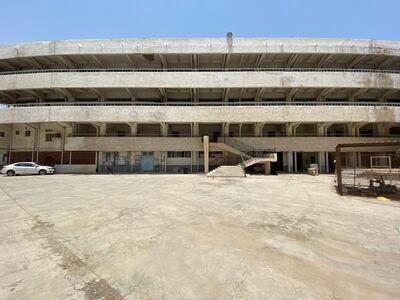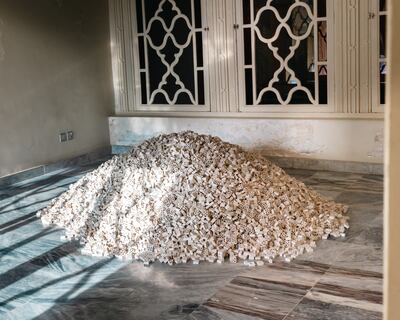The drive to preserve modern architecture in the Gulf continues, this time with an ambitious five-year initiative launched by the Jeddah firm Bricklab.
Looking at the period between 1938 – when oil was first discovered in Saudi Arabia – and 1964, the year after the first Jeddah master plan, Bricklab’s founders Turki and Abdulrahman Gazzaz are researching modern buildings across the kingdom: some of which have been demolished, and others that have simply been left in a state of disrepair. The duo are then refurbishing them, and commissioning artists and architects to produce exhibitions in the new venues. Afterwards, wherever possible, they will return the sites to contemporary use.
Titled Saudi Modern, the project will act as a mode of architectural preservation in a country where historical registers do not yet cover the modern period.
“The book – the first part of the project – looks at urban planning and examples of architecture from the modern period,” explains Turki, the younger of Bricklab's founder brothers, about the inaugural exhibition of the project, launched in Jeddah in December.
“The second part is the work of eight different contemporary artists and architects who interpret different themes. What we wanted to do with the exhibition was to create more of an experiential, less didactic way to exhibit this historical narrative.”

The project focuses on a time of intense change. Jeddah up until the 1940s was still largely a walled enclave, with most of the residences located in the dense Al Balad (now a Unesco World Heritage Site), and a few satellite communities.
As Al Balad grew more crowded, middle- and upper-class Jeddawis moved northwards to what was then the suburbs, and incoming Americans and Europeans, brought over after the oil discovery, formed groupings of self-contained communities.
In the late 1950s, the government invited Abdulrahman Makhlouf, the Egyptian urban planner who also designed the blueprint of Abu Dhabi, to lay out a master plan for the sprawling city. Makhlouf proposed the main northwards artery of Madinah Road, with smaller neighbourhoods strung along the sides, that is still recognisable today.
A 'spirit of unity and brotherhood'
Despite the historic importance of this period, the buildings that constituted it have since been overlooked. Their concrete material is seen as dated in comparison to the new materials of glass and steel, and many of the houses have been abandoned by their owners. But Bricklab sees in these buildings an unprecedented moment of societal transformation.
“In this early period, our grandfathers were literally moving from their stone and wood houses to concrete buildings,” says Turki. “This was a generation that encountered modernity first-hand and had to deal with reconciling traditional values with modern development and progress.”

The Tamer House, which Saudi Modern starts with, is typical of the time. It was built as a single-storey dwelling in 1954 for Dr Mohammed Saeed Tamer, a physician who had been directed in the 1920s to look after the pilgrims who were arriving in Jeddah. Sitting behind a walled garden, it is double-fronted, with a long, shaded balcony on which the family could sit outside. After one of his sons married and started a family, Dr Tamer built a second storey to accommodate them – as families did in generations past – and the house is now owned by his grandson, Faisal Tamer, a well-known arts supporter in Jeddah.
Saudi Modern’s 13 other case studies similarly span tradition and modernity, such as the Zainal House from the 1920s, a mix of Hejazi and colonial architecture that sat on an avenue known as “European Row”, or the curved, sinuous Al Ahli Housing Complex, an example of early modern subsidised development, from 1955.
All taken from the Gazzazs’ home town of Jeddah, the examples underline the city’s uniqueness – known locally by its informal motto, “Jeddah Ghair”, or “Jeddah different”. Sited on the Red Sea and the entry point for pilgrims to Makkah and Madinah, the city was long shaped by cosmopolitanism.
Even before 1938, for example, there was already an “Al Hinduwiyyah”, where a sizeable Indian and African community lived. As the city grew, some of the new developments expressly catered to religious pilgrims. Saudi Modern includes the Air Pilgrims Accommodation building from 1958, a multi-occupancy hotel near the old airport that offered cheap bed spaces for those en route to Makkah.

One of Air Pilgrims Accommodation's guests was the US civil-rights leader Malcolm X, who visited in 1964. He later reflected on the stay in his autobiography: “Above the airport was a huge, dormitory-like building four tiers high… Pilgrims from Ghana, Indonesia, Japan and Russia, to mention some, were moving to and from the dormitory…,” he wrote. In a postcard he sent at the time to a friend in New York, which is likewise documented in Bricklab's book, he added a line about “the spirit of unity & brotherhood like I’ve never seen before”.
The building is now set for demolition.
Modern to contemporary
For Saudi Modern's exhibition, Bricklab transformed the Tamer House into a show running through March, with provisional plans for the site to stay on as an arts centre. The works reflect both on the idea of a development, a frequent subject in Khaleeji art, as well as the specific setting of the building, of which the air-conditioners, sinks and bathtubs, sockets and wardrobe doors act as an eerie reminder of the regular family life that happened among its walls.

Palestinian architect Dima Srouji creates a video contrasting Palestine Street in Jeddah with Al Irsal Street in Ramallah. The double-channel work looks past the midcentury spirit of solidarity involved in the naming of the Saudi street to find contemporary connections based on less exalted impulses, such as fast-food chains and commercial storefronts (Once Upon a Solidarity, 2021).
Makhlouf appears in a documentary by Ahmed Mater in which he discusses the ideas behind his master plan.
Upstairs, in the landing for the house's wide, blocky staircase, Riyadh artist Alaa Tarabzouni shows a plethora of miniature breeze blocks. Perched in what was a bedroom nearby is Filwa Nazer's The hands want to see, the eyes want to caress (2021), for which the Saudi artist represented the layout of another 1950s-era vernacular house in Jeddah, the Bait Bajnaid. Sewing together aluminium mesh netting, polyester and different trimmings, Nazer creates a sense of diaphanous reminiscences, softening the repurposed rooms and acting as a reminder of the domesticity that one reigned there.

Art acts to preserve
Saudi Modern is one of a number of initiatives in the Gulf that are researching and preserving vernacular architecture. Others include the organisation Saudi Architecture in Riyadh, or Sultan Sooud Al Qassemi and Todd Reisz’s Building Sharjah, their extensive documentation of the 1970s building boom in Sharjah. Many of these are an indication of the role of the visual arts as an agent of architectural memory.
The phenomenon is not limited to the Gulf. Across Europe, for example, former factories are often repurposed as exhibition sites, rhetorically aligning art with sites of production, even if many art spaces could now be better compared to luxury showrooms. Refurbishment gives these sites a credibility, at times to the point of fetishisation. Despite its rhetoric of being aligned to the new, art often plays a recuperative role, memorialising modes that are no longer in service – such as Mater’s collection of old printing presses or artists' fascination with analogue film – and celebrating the authenticity of a building’s former purpose, even while using it for other means.

In the Gulf, however, the phenomenon goes beyond rhetoric, and has made art spaces an important mode of historical preservation. Though the UAE has built a number of museums, such as the Etihad Museum, Louvre Abu Dhabi or the planned Guggenheim Abu Dhabi, set for completion in 2025, other UAE outfits have repurposed existing sites, such as Bjarke Ingel’s acclaimed redesign of Warehouse421, the conversion of warehouses across Alserkal Avenue and Sharjah Art Foundation’s repurposed heritage sites (designed by Mona El Mousfy) and its preservation of The Flying Saucer and the Kalba Ice Factory.
Apart from being art spaces, these venues also keep alive the memories of the working buildings of Mina Zayed and Al Quoz, and the multilayered histories of sites in Sharjah.
This might be why Saudi Modern feels so – ironically – contemporary. The Gazzaz brothers come with an impeccable art pedigree: they represented Saudi Arabia at the Venice Biennale in 2018, are showing artwork in both the Diriyah Biennale and Hayy Jameel’s inaugural show, Staple: What’s on your Plate?, and are designing the country’s first art house cinema for that same Jameel complex. But the self-directed project of Saudi Modern might be their most important yet, not only for the historical research it produces but in cannily harnessing art's power to preserve.
Saudi Modern runs until Thursday, March 31 at the Dar Tamer in Al Sharafeyah, Jeddah

